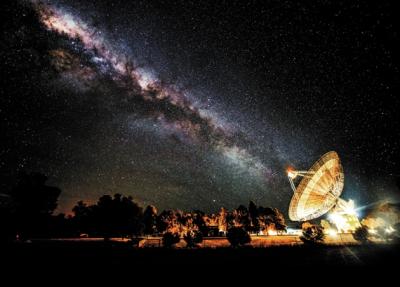Topic: SCIENCE - on July 5, 2016 at 4:06:00 PM CEST
Neutrinos hint at why antimatter didn’t blow up the universe
It could all have been so different. When matter first formed in the universe, our current theories suggest that it should have been accompanied by an equal amount of antimatter – a conclusion we know must be wrong, because we wouldn’t be here if it were true. Now the latest results from a pair of experiments designed to study the behaviour of neutrinos – particles that barely interact with the rest of the universe – could mean we’re starting to understand why. Neutrinos and their antimatter counterparts, antineutrinos, each come in three types, or flavours: electron, muon and tau. Several experiments have found that neutrinos can spontaneously switch between these flavours, a phenomenon called oscillating.

... Link (0 comments) ... Comment
Topic: SCIENCE - on July 4, 2016 at 10:58:00 AM CEST
Listen to the LHC’s Weird, Whale-Like Sounds
From their humble beginnings in a canister of hydrogen gas, stripped of their companion electrons and directed through a series of smaller accelerators, batches of protons (about 30 centimeters long and a few hundred micrometers thick) pick up energy in stages until they are ready to be injected into the Collider ring. It is impossible, though, to create a constant electric field strong enough, over enough of a distance, to get these charged particles anywhere near the speed required for the Collider’s experiments. Instead, the Collider uses so-called radio frequency cavities, eight of them for each beam going in opposite directions, spaced regularly around the ring. Inside them, an electric field oscillates back and forth, resonating at very high (radio) frequencies.
... Link (0 comments) ... Comment
Topic: SCIENCE - on July 2, 2016 at 5:03:00 PM CEST
LHCb unveils new particles
On 28 June, the LHCb collaboration reported the observation of three new "exotic" particles and the confirmation of the existence of a fourth one in data from the Large Hadron Collider (LHC). These particles seem to be formed by four quarks (the fundamental constituent of the matter inside all the atoms of the universe): two quarks and two antiquarks (that is, a tetraquark). Due to their non-standard quark content, the newly observed particles have been included in the broad category of so-called exotic particles, although their exact theoretical interpretation is still under study.

... Link (0 comments) ... Comment
Topic: SCIENCE - on July 2, 2016 at 4:49:00 PM CEST
3D-printing: German engineers create injectable micro-camera
German engineers have created a camera no bigger than a grain of salt that could change the future of health imaging — and clandestine surveillance. Using 3D printing, researchers from the University of Stuttgart built a three-lens camera, and fit it onto the end of an optical fibre the width of two hairs.
... Link (0 comments) ... Comment
Topic: SCIENCE - on June 30, 2016 at 11:18:00 AM CEST
Rare Dinosaur-Era Bird Wings Found Trapped in Amber
Bone, tissue, and feathers show the almost 100-million-year-old wings are remarkably similar to those on modern birds.
Two tiny wings entombed in amber reveal that plumage (the layering, patterning, coloring, and arrangement of feathers) seen in birds today already existed in at least some of their predecessors nearly a hundred million years ago.
A study of the mummified wings, published in the June 28 issue of Nature Communications and funded in part by the National Geographic Society's Expeditions Council, indicated they most likely belonged to enantiornithes , a group of avian dinosaurs that became extinct at the end of the Cretaceous period. (Read more about the evolution from dinosaurs to modern birds.)
... Link (0 comments) ... Comment
Topic: SCIENCE - on June 30, 2016 at 11:15:00 AM CEST
Why ultra-powerful radio bursts are the most perplexing mystery in astronomy
No astronomer had ever seen anything like it. No theorist had predicted it. Yet there it was — a 5-millisecond radio burst that had arrived on 24 August 2001 from an unknown source seemingly billions of light years away. “It was so bright, we couldn't just dismiss it,” says Duncan Lorimer, who co-discovered the signal1 in 2007 while working on archived data from the Parkes radio telescope in New South Wales, Australia. “But we didn't really know what to do with it.”

... Link (0 comments) ... Comment
Topic: SCIENCE - on June 22, 2016 at 6:26:00 PM CEST
How Quantum Mechanics Could Be Even Weirder
And what it could mean for the future of computing
Why doesn’t the world make sense? At the fundamental level of atoms and subatomic particles, the familiar “classical” physics that accounts for how objects move around gives way to quantum physics, with new rules that defy intuition. Traditionally these are expressed as paradoxes: particles that can be in two places at once, cats that are simultaneously alive and dead, apparently impossible faster-than-light signaling between distant particles. But quantum rules are perfectly logical and consistent—the “paradoxes” are the result of our trying to impose on them the everyday reasoning of classical physics.
... Link (0 comments) ... Comment
Topic: SCIENCE - on May 29, 2016 at 12:04:00 PM CEST
List of organisms named after famous people
In biological nomenclature, organisms often receive scientific names that honor a person. A taxon (e.g. species or genus; plural: taxa) named in honor of another entity is an eponymous taxon, and names specifically honoring a person or persons are known as patronyms. Scientific names are generally formally published in peer-reviewed journal articles or larger monographs along with descriptions of the named taxa and ways to distinguish them from other taxa. Following rules of Latin grammar, species or subspecies names derived from a man's name often end in -i or -ii if named for an individual, and -orum if named for a group of men or mixed-sex group, such as a family. Similarly, those named for a woman often end in -ae, or -arum for two or more women.
Anomphalus jaggerius Snail Mick Jagger Bumba lennoni Spider John Lennon Funkotriplogynium iagobadius Mite James Brown Montypythonoides riversleighensis Extinct reptile Monty Python Psephophorus terrypratchetti Turtle Terry Pratchett Tetramorium adamsi Ant Douglas Adams
... Link (0 comments) ... Comment
Topic: SCIENCE - on February 22, 2015 at 4:41:00 PM CET
Pottwal verteidigt sich mit einer Wolke aus Kot
Unterwasserfotograf hält ungewöhnliche Begegnung fest. Mit knapp 20 Metern Länge und einem Gewicht von 50 Tonnen sind Pottwale die größten Jäger unseres Planeten. Ein ausgewachsenes Exemplar hat keine natürlichen Feinde - und doch scheint sich die Spezies einen Verteidigungsmechanismus bewahrt zu haben, den man auch von ihrem nächsten Verwandten, dem bedeutend kleineren Zwergpottwal, kennt.
... Link (0 comments) ... Comment
Topic: SCIENCE - on November 10, 2014 at 5:47:00 PM CET
CERN May Not Have Discovered Higgs Boson After All
Physicists Peter Higgs and Francois Englert won the Nobel Prize for discovering the Higgs Boson, but some scientists believe that the particle may not have been discovered yet at all. A new study by a group of scientists from the University of Southern Denmark raises the possibility that the data collected from the Large Hadron Collider could instead explain another type of subatomic particle. Mads Toudal Frandsen, a particle physicist, explained in a statement, "The CERN data is generally taken as evidence that the particular particle is the Higgs particle ... It is true that the Higgs particle can explain the data but there can be other explanations, we would also get this data from other particles.
... Link (0 comments) ... Comment
Topic: SCIENCE - on August 15, 2014 at 4:39:00 PM CEST
Hemp Fibers Make Better Supercapacitors Than Graphene
BBC News is reporting findings published in the journal ACS Nano by Dr David Mitlin from Clarkson University. Dr. Mitlin's team took waste hemp stems and recycled the material into supercapacitors with performance as good, or better, than those built from graphene, at a fraction of the raw materials cost. "We're making graphene-like materials for a thousandth of the price - and we're doing it with waste. The hemp we use is perfectly legal to grow. It has no THC in it at all - so there's no overlap with any recreational activities,
... Link (0 comments) ... Comment
Topic: SCIENCE - on August 13, 2014 at 5:16:00 PM CEST
Scientists Announce Worlds Fastest Camera, Capable of Capturing 4.4 Trillion Frames Per Second
No, that’s not a typo. A team of 12 scientists from The University of Tokyo and Keio University, have developed a camera that is capable of capturing 4.4 trillion frames per second using a technology called Sequentially Timed All-optical Mapping Photography (STAMP) according to a release posted on Nature.com. According to the team, STAMP makes it possible for their camera to outperform current high speed cameras by achieving capture rates that are 1,000 times faster than any other known camera.
... Link (0 comments) ... Comment










